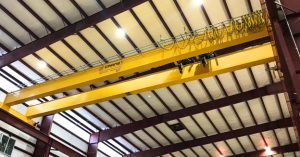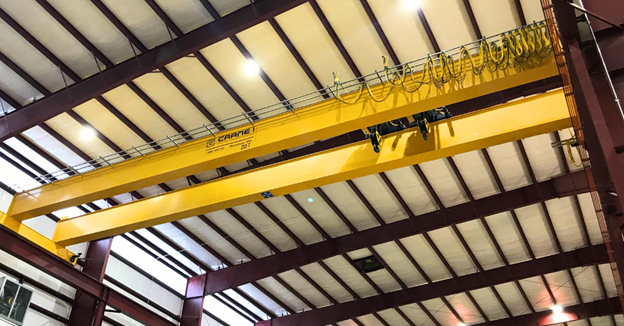For decades, overhead crane systems have been the backbone of countless industrial operations—lifting, transporting, and positioning heavy materials with efficiency and reliability. But as technology advances, older systems may fall behind in performance, safety, and energy efficiency. Overhead Crane Modernization offers a strategic way to revamp these vital assets by integrating cutting-edge material handling technologies.

Crane 1 Services recognizes the pivotal role overhead cranes play. This article explores the top five material handling technologies to consider during an Overhead Crane Modernization project—each one designed to increase efficiency, reduce maintenance costs, and improve overall safety and productivity.
1. Variable Frequency Drives (VFDs)
One of the most impactful upgrades for an overhead crane system is the integration of Variable Frequency Drives, commonly known as VFDs. These sophisticated electronic devices control the speed of the electric motors that power the crane’s various motions, including hoisting, trolley travel, and bridge travel. Unlike traditional contactor-based control systems that offer only fixed speeds, VFDs provide infinitely variable speed control.
Why Include in Your Overhead Crane Modernization:
- Smooth and Precise Load Control – VFDs allow for gradual acceleration and deceleration, minimizing load swing and providing operators with exceptional control during critical lifting and positioning tasks. This is particularly beneficial when handling delicate or sensitive materials. For example, in a manufacturing setting, a VFD can enable the precise placement of a large, fragile component onto an assembly line without any jarring movements.
- Reduced Mechanical Stress and Wear – The elimination of sudden starts and stops significantly reduces the mechanical stress on the crane’s components, such as gears, brakes, and wire ropes. This translates directly into lower maintenance requirements, fewer breakdowns, and an extended lifespan for the crane system. Imagine a crane that no longer experiences the abrupt jolts that can lead to premature wear on its motor bearings.
- Energy Efficiency – VFDs optimize motor performance by supplying only the necessary amount of power required for the specific task. This results in significant energy savings compared to traditional systems that often run motors at full speed regardless of the load. Over time, these energy savings can contribute substantially to a facility’s bottom line.
- Improved Safety – The enhanced control offered by VFDs contributes to a safer working environment. Smooth movements reduce the risk of accidental load drops or collisions, protecting personnel and equipment. For instance, when moving a heavy mold in a plastics factory, the precise control afforded by a VFD minimizes the chance of the mold swinging and potentially causing injury.
2. Advanced Radio Control Systems
Modern radio control systems represent a significant leap forward from traditional pendant controls. These wireless systems provide operators with greater freedom of movement and improved visibility of the load and surrounding work area.
Why Include in Your Overhead Crane Modernization:
- Increased Operator Safety – By allowing operators to position themselves in the most advantageous location, radio controls minimize their proximity to the moving load and potential hazards. This is particularly crucial in large or complex workspaces where pendant controls can restrict the operator’s view. Consider a steel mill where an operator using a radio control can maintain a safe distance from extremely hot materials while still having a clear line of sight.
- Improved Operator Efficiency and Ergonomics – Wireless control eliminates the constraints of trailing cables, allowing operators to move freely and choose the optimal vantage point for controlling the crane. This can lead to faster and more efficient material handling operations, as well as reduced operator fatigue. Imagine an operator in a warehouse being able to walk around a large piece of machinery to guide its placement precisely using a radio control.
- Enhanced Communication and Coordination – Some advanced radio control systems offer features such as two-way communication, allowing operators to receive feedback on load weight or system status. This can improve coordination between the crane operator and ground personnel, further enhancing safety and efficiency.
- Customizable Features and Diagnostics – Modern radio control systems often come with customizable buttons and displays, allowing for tailored operation to specific tasks. Many systems also include diagnostic capabilities, providing valuable information about the crane’s performance and potential issues.
3. Smart Monitoring and Diagnostics
Integrating smart monitoring and diagnostic systems into an overhead crane provides real-time insights into the crane’s operational status and component health. These systems utilize sensors and data analytics to identify potential problems before they lead to costly breakdowns.
Why Include in Your Overhead Crane Modernization:
- Predictive Maintenance Capabilities – By continuously monitoring key parameters such as motor current, vibration levels, and temperature, these systems can detect anomalies that may indicate impending failures. This allows for proactive maintenance interventions, scheduling repairs before a breakdown occurs and minimizing downtime. For example, a system might detect a gradual increase in motor current, indicating a potential bearing issue that can be addressed during a scheduled maintenance window.
- Reduced Downtime and Maintenance Costs – Predictive maintenance significantly reduces unscheduled downtime, which can be extremely costly in terms of lost production. By addressing potential issues early, businesses can avoid major repairs and extend the life of their crane components. Imagine avoiding a complete production halt because a potential gearbox issue was identified and resolved before it failed catastrophically.
- Improved Safety and Reliability – Early detection of potential problems not only reduces downtime but also enhances the safety and reliability of the crane system. Identifying and addressing worn or faulty components before they fail ensures safer lifting operations.
- Data-Driven Decision Making The data collected by these systems provides valuable insights into crane utilization, performance trends, and maintenance requirements. This information can be used to optimize operational procedures, plan future maintenance activities more effectively, and make informed decisions about crane upgrades or replacements.
4. Anti-Collision Systems
In environments where multiple overhead cranes operate in close proximity on the same runway, the risk of collisions poses a significant safety hazard. Implementing anti-collision systems is a crucial modernization step to mitigate this risk and protect personnel and equipment.
Why Include in Your Overhead Crane Modernization:
- Prevention of Crane-to-Crane Collisions – These systems utilize sensors, such as ultrasonic, laser, or radar, to detect the presence of other cranes on the same runway. If a crane gets too close to another, the system can issue warnings and automatically initiate braking to prevent a collision.
- Protection of End Stops and Structures – Anti-collision systems can also be configured to prevent cranes from colliding with runway end stops or other fixed structures within the facility. This helps to avoid damage to the crane and the building infrastructure.
- Zoned Operation and Restricted Areas – Some advanced anti-collision systems allow for the creation of virtual zones or restricted areas. If a crane enters one of these designated zones without authorization, the system can issue warnings or automatically stop the crane’s movement.
- Increased Operator Awareness – While the anti-collision system provides an automated layer of protection, it also enhances operator awareness of the surrounding environment and the positions of other cranes.
5. Automated and Semi-Automated Controls
For repetitive lifting and material handling tasks, incorporating automated or semi-automated control systems can significantly boost efficiency and reduce the need for continuous operator intervention.
Why Include in Your Overhead Crane Modernization:
- Increased Efficiency and Throughput – Automated systems can perform repetitive tasks with consistent speed and accuracy, leading to higher throughput and reduced cycle times. For example, in a precast concrete plant, an automated crane can be programmed to lift and move molds between different stages of the production process without direct operator control for each movement.
- Reduced Labor Costs – By automating certain material handling operations, businesses can reduce their reliance on manual labor, leading to significant cost savings over time.
- Improved Accuracy and Consistency – Automated systems follow pre-programmed paths and movements, ensuring consistent and accurate material handling, minimizing errors and damage to materials.
- Enhanced Safety in Hazardous Environments – Automation allows for material handling in environments that may be hazardous for human operators, such as extreme temperatures or areas with exposure to harmful substances. A semi-automated system might allow an operator to supervise a lifting operation from a safe distance while the system executes the precise movements.
Investing in Overhead Crane Modernization is investing in the future of your operation. Technologies like VFDs, wireless controls, smart diagnostics, anti-collision, and automation dramatically enhance performance, safety, and reliability.
At Crane 1 Services, we specialize in Overhead Crane Modernization, helping businesses unlock new levels of productivity. Whether you’re upgrading a single crane or modernizing your entire system, our experts deliver tailored solutions with expert installation and ongoing support.
Contact us at (888) 316-2617 today to start your Overhead Crane Modernization journey with a trusted partner.
